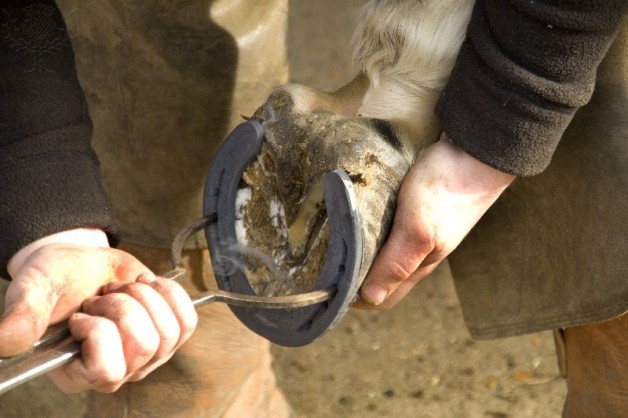By Marie Rosenthal
In a game of horseshoes, close might be good enough. But your horse’s own shoes and hooves require skill, knowledge, and precision: in essence, a farrier who is right for your horse and riding discipline.
“Good podiatric care is the essence of not only the performance of the day, but also the longevity of the horse,” says David Duckett, FWCF (fellow of the Worshipful Company of Farriers), a master farrier and blacksmith based in Ambler, Pennsylvania.
A quality farrier does far more than just shoe a horse’s foot. He trims the hooves, assesses the horse’s gait, addresses any pathologic (disease) problems the horse might have in his feet, and helps keep the horse pain-free.
“An inexperienced person can create many problems for your horse by causing immediate lameness, but more importantly they can create more serious issues over the long term,” Duckett explains. “If the horse is not shod correctly, the animal is compelled to compensate for that lack of specific adjustments in the hoof preparation and trim.” As a result, many anatomical parts wear prematurely.
“In the long term it is possible the horse may develop conditions that you may not associate with the incorrect trimming done some time ago,” adds Duckett, who compares good farriery with good vehicle maintenance. “If you want your motor vehicle to run efficiently and smoothly, you need to change the oil regularly. If you don’t, your truck may be running okay now, but just wait until you’ve driven some miles–it will break down.”
So how does an owner find the right farrier for his or her horse?
1. Consider Education
A farrier should be knowledgeable about his field. Unfortunately, in the United States almost anyone can trim and shoe horses because no licensing or certification is required. “Some racetracks mandate credentialing, but unlike our European colleagues, who do have guild requirements, here in the United States there are no legal requirements to be a farrier,” says Tracy A. Turner, DVM, MS, Dipl. ACVS, of Anoka Equine Veterinary Services in Elk River, Minnesota. “Anyone can put up a shingle and start shoeing horses tomorrow.”
Duckett hails from the United Kingdom, where the path to journeyman farrier is long and strenuous. “In England there are laws against anyone shoeing horses for gain unless they have completed the statutory requirements and appropriate education,” he explains.
Duckett attended mandatory schooling for five years and had to pass written, oral, and practical examinations before he could legally charge for his services. This is only the first level of education, but it enables a successful student’s name to be placed in a professional registry. To become a journeyman or master farrier requires more time, effort, and expense.
“There is a second level that is not mandatory that is an associate degree (AWCF, or associate of the Worshipful Company of Farriers),” says Duckett. “Then, a third level, which is the hardest, requires a thesis on a given topic, to hand-forge shoes for pathological conditions, read radiographs (X rays), give a lecture, a written exam followed by an oral discussion with both master farriers and veterinarians. … All these add up to an extensive scrutiny of one’s level and depth of knowledge to become a fellow of the Worshipful Company of Farriers.”
Before a farrier handles a horse, he or she should be well-versed in equine anatomy, physiology, and biomechanics. He should also be able to read a radiograph of the foot to converse with the veterinarian on any given issue your horse might have.
“When it comes time to look for a good farrier, look for someone who has gone beyond a short training course,” Turner says. “Ask the potential farrier where they learned how to shoe. Did they have an apprenticeship? Did they go to school?”
Because there are no formal requirements in the U.S., many proactive farriers seek certification. The primary and most recognized one is the American Farriers Association’s (AFA) certification: Certified Journeyman Farrier (CJF). The Worshipful Company of Farriers (WCF) of London, England, recently approved an examination center in Colorado. This will allow candidates wishing to pursue a higher level of farriery to sit the Worshipful Company’s examinations without the expense of a trip to England, Duckett says.
Don’t be afraid to interview your potential farrier about certification or question your present one, following up with the AFA and WCF.
In addition, Duckett suggests you ask what hoof care journals or scientific papers your farrier reads and whether he or she belongs to any of the farrier associations. Ask if he or she has taken any continuing education courses or attended any lectures recently. Someone who wants to be on the cutting edge of the industry will keep up-to-date with the latest technology and scientific findings.
2. Consider Experience
A farrier’s experience in the field also is important, especially if the person has no formal education or certification (however, Duckett and Turner still advise you seek out a farrier who has earned an AFA certification or its equivalent). “They need to be shoeing on a regular basis for a couple of years,” Turner says. “It is not something you can get good at by doing on weekends.”
Furthermore, just because a person works on a horse’s feet does not automatically qualify him to be a farrier.
Duckett adds, “A farrier is an individual who is well-educated within the field and well-practiced. In recent years there are quite a number of well-educated farriers with college and university degrees that have excelled in the art and science of farriery by introducing new, innovative concepts and research. Their efforts are not only groundbreaking but breaking the bonds of a centuries-old tradition by questioning the status quo with modern technology, computers, slow motion analysis, and foot plate sensors. The work these farriers are doing is exemplary and should continue to be supported by the equine industry.”
Be sure to ask potential farriers how long they have been trimming or shoeing horses and whether they have been doing it regularly.
3. Consider Horsemanship
Observe how a prospective farrier interacts with the horse to find someone who knows how to handle horses properly.
“When the farrier comes out, watch how he assesses the foot, how he approaches the horse, how he picks up the feet, how he works with the horse standing there. Is he calm, etc.? These are all good things,” Turner says.
Furthermore, if a farrier has good horsemanship skills, he is likely to be conscientious about learning how to best trim and shoe your horse. You want to work with someone who is genuinely interested in your horse’s welfare.
Does the person spend time watching how the horse moves and lands on his feet? Does he carefully look at and assess the foot? Does the farrier work quietly and calmly around the horse, or does he jerk the horse around? Does he raise his voice higher than necessary to get the animal’s attention?
“You do not want to see any abuse to the animal, but you sometimes have to be firm,” Duckett says. He recommends only owners or trainers, and not necessarily the farrier, restrain the animal if needed.
4. Ask for a Referral
The horse community is a small world, so there are several individuals you can go to to ask for a farrier recommendation. Talk to your trainer, veterinarian, stable help, and other horse owners about who they use and what they like about that farrier. Your veterinarian can be a particularly useful reference if your horse has a pre-existing foot condition, such as navicular syndrome or chronic laminitis, and requires special shoeing.
“Word of mouth is very handy,” Turner says, but bear in mind that people have different definitions of “good work.”
“A person can get guidance from a trainer or barn manager or other owners in the barn,” Duckett adds. “However, there are times when there is a personal connection with the recommended horseshoer, so it can be difficult to sort through the chaff to get a good person.”
Although all AFA-certified farriers have demonstrated competency in shoeing a range of horses, some do specialize in a particular breed or riding discipline. For instance, if you ride gaited horses, you might want to seek out a farrier who has extensive experience with that breed’s special footwear and shoeing requirements. Contact area trainers or organizations that share your equestrian interest and ask for recommendations of farriers with experience shoeing for your discipline. If a farrier has clients at a reputable facility or with a top trainer, he is likely very good at his job.
5. Consider Someone Who is Responsible
When considering a farrier, make sure he is enthusiastic about his work, does not rush through a trim or a shoeing, and does the job correctly. Also choose someone who is easy to communicate with, as communication between horse owner and farrier is key to developing a good relationship and an understanding of your horse’s needs and your goals and financial limits.
Duckett says it also helps if the farrier keeps his word and is punctual. “A good farrier who’s made an appointment will tell you if he is running late by a simple phone call,” he says. “If he is persistently late or doesn’t turn up at all, I’d look for someone else. If he is not responsible with you or his own business, he’s not going to be responsible with your horse.”
Determine ahead of time whether a farrier is willing to work with your veterinarian in the case of any injury or hoof condition. Also make sure he is easy-to-reach during an emergency situation or in case of a thrown or twisted shoe.
6. Don’t Buy on Cost Alone
The cost of a farrier’s services will vary by region and the horse’s hoof care needs. To get a feel for reasonable fees in your area, Turner recommends that you ask around and see what other people are paying for similar horses’ hoof care. Ask your prospective farrier about pricing, payment, and other concerns (e.g., emergency visits, lost shoe replacement, special shoeing requirements) up front. Compare several individuals’ fees, but don’t choose one farrier just because he’s cheaper than the guy down the road, Turner warns. You (or your horse) might pay for it in the long run.
“Experience is not something you gain from the library or the Internet,” Duckett says. “Experience is something you get by living it and doing it. The important issue is not the cost, but the quality of service you receive.”
“You want a sound horse with a good-looking foot when he’s finished,” adds Turner. “If the feet look worse, or the horse is lame when the job is done, there is something wrong. No farrier should make a horse worse.”
Take-Home Message
It takes a little effort to find the right farrier, but for your horse’s sake and soundness it’s worth it. “Don’t use someone who lacks patience, is too busy to do the job right, or treats the horse rough,” Turner says. “If you follow these things, you’ll find someone who has done this a lot, and things will go smoothly.”



